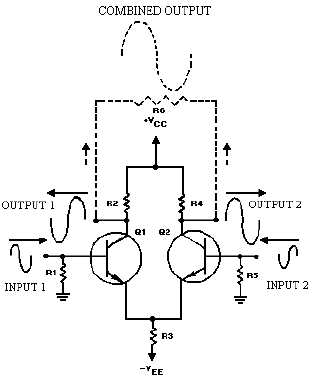3-14
Figure 3-9.—Differential-input, differential-output differential amplifier.
Normally, this configuration uses two input signals that are 180 degrees out of phase. This causes the
difference (differential) signal to be twice as large as either input alone. (This is just like the two-input,
single-output difference amplifier with input signals that are 180 degrees out of phase.)
Output number one is a signal that is in phase with input number two, and output number two is a
signal that is in phase with input number one. The amplitude of each output signal is the input signal
multiplied by the gain of the amplifier. With 180-degree-out-of-phase input signals, each output signal is
greater in amplitude than either input signal by a factor of the gain of the amplifier.
When an output signal is taken between the two output terminals of the amplifier (as shown by the
phantom connections, resistor, and signal), the combined output signal is twice as great in amplitude as
either signal at output number one or output number two. (This is because output number one and output
number two are 180 degrees out of phase with each other.) When the input signals are 180 degrees out of
phase, the amplitude of the combined output signal is equal to the amplitude of one input signal
multiplied by two times the gain of the amplifier.
When the input signals are not 180 degrees out of phase, the combined output signal taken across
output one and output two is similar to the output that you were shown for the two-input, single-output,
difference amplifier. The differential amplifier can have two outputs (180 degrees out of phase with each
other), or the outputs can be combined as shown in figure 3-9.
In answering Q7 through Q9 use the following information: All input signals are sine waves with a
peak-to-peak amplitude of 10 millivolts. The gain of the differential amplifier is 10.
Q-7.
If the differential amplifier is configured with a single input and a single output, what will the
peak-to-peak amplitude of the output signal be?

